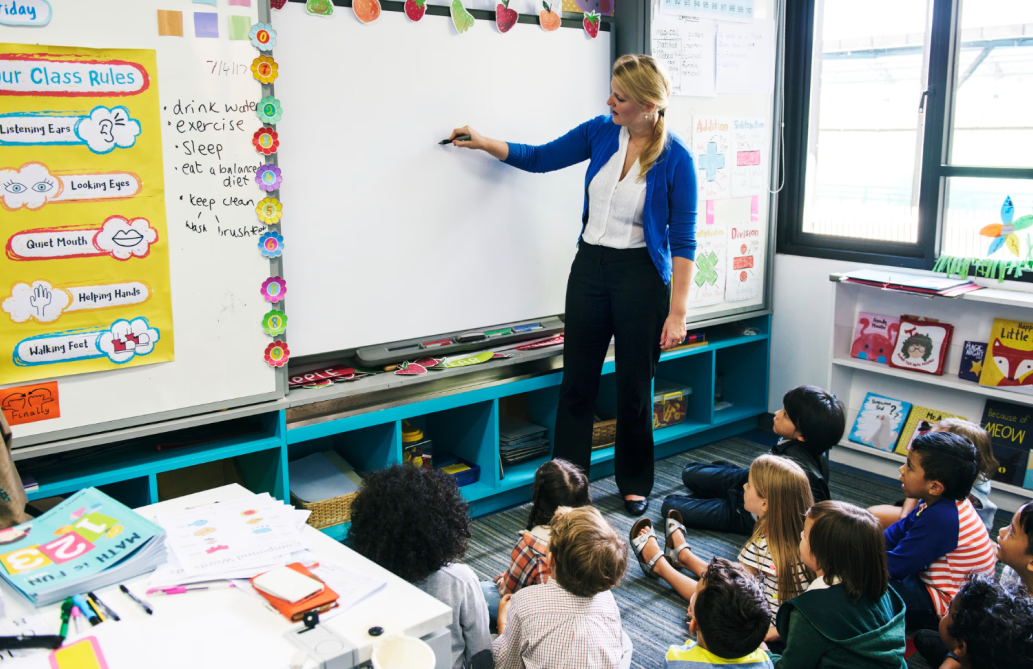As a teacher, you know that your job goes far beyond just showing up to deliver lessons. Your role is a delicate balance of juggling different tasks—lesson planning, managing a classroom, assessing students, and even communicating with parents. And that’s just the beginning.
If you’ve ever wondered exactly what it is that teachers are responsible for, here’s a breakdown of the Top 10 responsibilities of a teacher that help shape students’ futures and make the classroom a better place.
Whether you’re new to teaching or you’ve been teaching for years, understanding these core responsibilities can help you reflect on what you’re already doing well and maybe even offer a few ideas for how you can improve. So let’s dive into these responsibilities:
We've all had those days where we walk into class without a fully fleshed-out lesson plan, hoping to wing it. But deep down, we know that well-prepared lessons are the backbone of any successful class.
Lesson planning is more than just writing down what you'll teach; it's about creating a roadmap that ensures every lesson is structured, engaging, and aligned with learning objectives. This is one of the essentials of the top 10 responsibilities of a teacher in the classroom, as it provides direction and clarity.
This is one of the essentials of the top 10 responsibilities of a teacher in the classroom, as it provides direction and clarity. Effective lesson plans should cater to the diverse needs of your students, including different learning styles, interests, and abilities.
Understanding what are the duties and responsibilities of a teacher is crucial in this context, as it encompasses not only lesson planning but also classroom management, assessment, and fostering a positive learning environment.
Effective teaching is only possible if you manage your classroom, no matter how brilliant your lesson plan is. Classroom management creates an environment where students feel safe, respected, and ready to learn.
It involves setting clear expectations, enforcing rules, and fostering a positive classroom culture, making it a vital component of the top 10 responsibilities of a teacher in the classroom.
Strong classroom management helps minimize disruptions, allowing for more learning time and fewer behavior issues. But it’s more than just keeping students in line—it’s about creating a space where students can thrive, feel valued, and be encouraged to participate actively.
Instruction delivery is the heart of teaching—it's more than just standing in front of a class and talking. It involves engaging your students, holding their attention, and ensuring they understand the material. Since students learn in various ways, it’s essential to use diverse teaching strategies, from direct instruction and discussions to hands-on activities and technology-based tools.
Good instruction makes the subject matter relatable and exciting. Whether explaining a complex scientific concept or discussing literature, your goal is to help students understand and care about what they’re learning. Effective delivery is key to the top 10 responsibilities of a teacher in a school setting, influencing the entire learning experience.
In addition to teaching, there are duties of a teacher other than teaching that are vital for a well-rounded learning environment, such as planning lessons, assessing student performance, managing classroom discipline, collaborating with colleagues, communicating with parents, and continually enhancing your skills.
You can only know how well your students learn if you assess them regularly. Student assessment is crucial because it helps measure learning outcomes, identify gaps, and adjust your teaching methods accordingly. Assessments don’t always have to be formal tests—they can also be informal check-ins or observations.
Assessments give you a clear picture of your student’s progress, allowing you to tailor future lessons to address any issues. More importantly, assessments help students understand where they stand and how to improve, giving them ownership of their learning journey.
This is a key element in the top 10 responsibilities of a teacher in a school, guiding the overall academic direction.
Grading and providing feedback are closely tied to assessment. Grading assignments and tests is more than just giving students a score—it’s about offering meaningful feedback that helps them grow. Constructive feedback enables students to understand their strengths and weaknesses, providing clear guidance on how to improve.
While grading is often seen as a tedious task, it’s one of the most important ways to communicate with your students about their progress. Timely, specific, and encouraging feedback helps students stay motivated and engaged in learning.
This is also crucial when considering the duties of a teacher other than teaching, such as mentoring and administrative responsibilities.
Teachers and parents form a team when it comes to student success. Communication with parents is vital to your role because it keeps them informed about their child's progress, strengths, and areas that need improvement. Regular updates can help parents provide better support at home, ensuring that students are consistently supported both in and out of the classroom.
Whether through emails, report cards, or parent-teacher meetings, maintaining open lines of communication with parents helps build a robust support system for your students. This is one of the essential duties of a teacher other than teaching, impacting not only the classroom but also the broader school community. Additionally, understanding what are the duties and responsibilities of a teacher allows you to navigate these interactions effectively and foster a collaborative environment for student success.
Teaching is a constantly evolving field, and as a teacher, you need to stay on top of the latest trends and strategies. Professional development is about continuously improving your skills, learning new teaching methods, and staying current with the latest educational technologies.
It’s one of the top 10 responsibilities of a teacher in a school, where growth is essential for keeping up with academic standards.
Ongoing learning helps you become a more effective teacher, whether through attending workshops, getting certified in new areas, or simply reading the latest research. Additionally, professional development keeps your teaching fresh and engaging, ensuring that you’re implementing the best practices out there.
Beyond the academic side of things, teachers often mentor their students, offering guidance, support, and encouragement beyond the curriculum. Mentorship can profoundly impact students, helping them navigate personal challenges and making them feel valued.
Being a mentor doesn't mean solving all of a student's problems; it’s about being there when they need advice, offering a listening ear, and guiding them toward positive solutions. The duties and responsibilities of a teacher extend beyond academics, and mentorship is a perfect example of this broader role.
One of the less glamorous but essential responsibilities of a teacher is record keeping.
Maintaining detailed records of student attendance, grades, behavior, and progress is critical for tracking student performance and identifying patterns. These records inform teaching strategies and ensure no student falls through the cracks, often requiring the use of the top 10 responsibilities of a teacher pdf for easy reference.
Effective record-keeping also ensures you have accurate data to share during parent-teacher meetings and when making decisions about a student's needs.
By staying organized and diligent, you can provide valuable insights that support both student learning and parental engagement. This approach not only enhances your teaching effectiveness but also fosters stronger relationships with parents, ensuring a collaborative effort in supporting each student’s educational journey.
Finally, one of your most important responsibilities is ensuring inclusive education. Every student deserves the opportunity to succeed, regardless of background, learning abilities, or personal circumstances.
You must create a classroom environment where every student feels included, respected, and supported. Fostering inclusivity is a key duty of a teacher, as no student should feel left out.
This could involve modifying assignments for students with learning disabilities, using culturally relevant materials, or simply fostering an environment where diversity is celebrated.
Teaching is a multifaceted profession that goes far beyond simply delivering lessons. The Top 10 responsibilities of a teacher reflect the many roles you play in shaping not only your students' academic abilities but also their personal growth and development. These top 10 responsibilities of a teacher in a school emphasize your pivotal role in guiding students through their educational journey and fostering a supportive learning environment.
By balancing these responsibilities, you help create a classroom where every student can thrive. As you continue to grow in your teaching journey, exploring new strategies and upskilling opportunities can make a significant difference in managing these responsibilities.
For personalized guidance on which programs might be right for you, consider reaching out to a teacher career expert to help you take the next step in your career.















